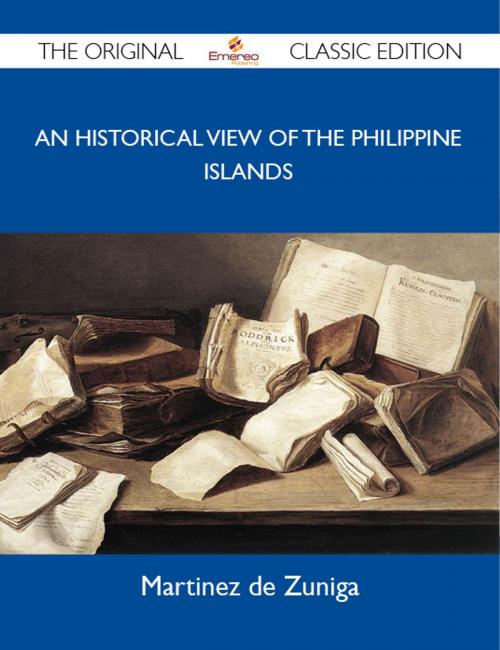An Historical View of the Philippine Islands - The Original Classic Edition
Nonfiction, Reference & Language, Reference, Fiction & Literature| Author: | Zuniga Martinez | ISBN: | 9781486420988 |
| Publisher: | Emereo Publishing | Publication: | October 24, 2012 |
| Imprint: | Emereo Publishing | Language: | English |
| Author: | Zuniga Martinez |
| ISBN: | 9781486420988 |
| Publisher: | Emereo Publishing |
| Publication: | October 24, 2012 |
| Imprint: | Emereo Publishing |
| Language: | English |
This is a new and freshly published edition of this culturally important work by Martinez de Zuniga, which is now, at last, again available to you.
Enjoy this classic work today. These selected paragraphs distill the contents and give you a quick look inside An Historical View of the Philippine Islands:
The established intercourse of these islands with Japan and China offers a ready transit for [vii]manufactures; and although it is understood that the East India Company furnishes an adequate supply of our woollen staple to the China market, we may yet fairly expect that British enterprize will not overlook the advantages which the opening of the India trade holds out in this quarter; nor will the introduction of British manufactures into these islands, either with an ultimate view to the above markets, or to those of Spanish America, in any material degree interfere with the staple trade of the Company: there is full scope for adventure in this new vineyard, and labourers will not be wanting.
...The translator has found him too often occupying his pages with contentions between the respective religious orders, insignificant in their nature even to a Spaniard, and so much more so to the English reader, that he has taken the liberty of altogether omitting them in the translation, except where connected with the political affairs of the settlement; and although by these means several of the chapters are reduced to almost nominal importance; yet considering the division of the subject in this form as adopted on fair grounds by the author, he [ix]hopes he will be deemed justifiable in retaining it even with the sacrifice of something of appearance.
...It is certainly consonant to reason to presume that the aborigines, or mountaineers of the interior of these islands, in their primitive state, were more likely to change their residence (if intentionally) by committing themselves to a favourable breeze blowing pretty constantly in one direction from the eastward; or if in consequence of misfortune, by finding their efforts unavailing to encounter an adverse wind, and again reach their own coasts; than to suppose even with all the aid the monsoons could afford them in an erratic navigation from Africa through the Indian ocean to the Archipelago, that they should diffuse themselves from that point in every direction over the South Sea, in the face of an almost constant current of wind, blowing occasionally with extreme violence.
...He takes this opportunity of expressing his gratitude for the kind assistance afforded by Captain Horsburgh, Hydrographer to the East India Company, who has had full opportunity, for the exercise of his practical and theoretical acquirements as a navigator in the eastern Archipelago, and who surveyed the western coasts of these islands, and in particular the northern extremity of the island of Luzon; to him he owes the correction of many errors, in respect to latitude [xv]and longitude, which disgrace the existing charts; and to him likewise the map is indebted, for a more perfect delineation of the coasts, and for the disappearance of certain dangerous rocks which he has ascertained to have no existence.
...This may be more matter of accident than of proof, that the languages of one and the other is the same; but on observing, besides this, that the proper names of places about the middle of the continent of South America are very similar to those of the Philippines, I endeavoured to procure a vocabulary of this country, and did not fail to examine, with great diligence and attention, the few words of the language of Chili which Ercilla mentions in his Araucana, and which I found perfectly conformable to the language Tagala.
This is a new and freshly published edition of this culturally important work by Martinez de Zuniga, which is now, at last, again available to you.
Enjoy this classic work today. These selected paragraphs distill the contents and give you a quick look inside An Historical View of the Philippine Islands:
The established intercourse of these islands with Japan and China offers a ready transit for [vii]manufactures; and although it is understood that the East India Company furnishes an adequate supply of our woollen staple to the China market, we may yet fairly expect that British enterprize will not overlook the advantages which the opening of the India trade holds out in this quarter; nor will the introduction of British manufactures into these islands, either with an ultimate view to the above markets, or to those of Spanish America, in any material degree interfere with the staple trade of the Company: there is full scope for adventure in this new vineyard, and labourers will not be wanting.
...The translator has found him too often occupying his pages with contentions between the respective religious orders, insignificant in their nature even to a Spaniard, and so much more so to the English reader, that he has taken the liberty of altogether omitting them in the translation, except where connected with the political affairs of the settlement; and although by these means several of the chapters are reduced to almost nominal importance; yet considering the division of the subject in this form as adopted on fair grounds by the author, he [ix]hopes he will be deemed justifiable in retaining it even with the sacrifice of something of appearance.
...It is certainly consonant to reason to presume that the aborigines, or mountaineers of the interior of these islands, in their primitive state, were more likely to change their residence (if intentionally) by committing themselves to a favourable breeze blowing pretty constantly in one direction from the eastward; or if in consequence of misfortune, by finding their efforts unavailing to encounter an adverse wind, and again reach their own coasts; than to suppose even with all the aid the monsoons could afford them in an erratic navigation from Africa through the Indian ocean to the Archipelago, that they should diffuse themselves from that point in every direction over the South Sea, in the face of an almost constant current of wind, blowing occasionally with extreme violence.
...He takes this opportunity of expressing his gratitude for the kind assistance afforded by Captain Horsburgh, Hydrographer to the East India Company, who has had full opportunity, for the exercise of his practical and theoretical acquirements as a navigator in the eastern Archipelago, and who surveyed the western coasts of these islands, and in particular the northern extremity of the island of Luzon; to him he owes the correction of many errors, in respect to latitude [xv]and longitude, which disgrace the existing charts; and to him likewise the map is indebted, for a more perfect delineation of the coasts, and for the disappearance of certain dangerous rocks which he has ascertained to have no existence.
...This may be more matter of accident than of proof, that the languages of one and the other is the same; but on observing, besides this, that the proper names of places about the middle of the continent of South America are very similar to those of the Philippines, I endeavoured to procure a vocabulary of this country, and did not fail to examine, with great diligence and attention, the few words of the language of Chili which Ercilla mentions in his Araucana, and which I found perfectly conformable to the language Tagala.















